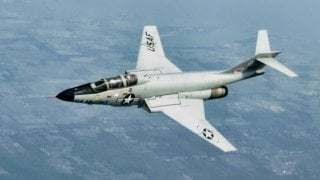F-101 Voodoo: A Cold War Fighter That Went All Out to Beat Russia
The McDonnell F-101 Voodoo, part of the "Century Series" of fighter aircraft, was a cutting-edge jet when it first flew in 1954. Initially designed as a long-range bomber escort, it evolved into a nuclear-armed fighter-bomber and later served as a photo-reconnaissance aircraft until 1979.
Summary and Key Points: The McDonnell F-101 Voodoo, part of the "Century Series" of fighter aircraft, was a cutting-edge jet when it first flew in 1954. Initially designed as a long-range bomber escort, it evolved into a nuclear-armed fighter-bomber and later served as a photo-reconnaissance aircraft until 1979.
-In 1957, the Voodoo set a world speed record for jet-powered aircraft at 1,207 mph. Developed from the XF-88 prototype, the F-101 featured significant upgrades, including powerful Pratt & Whitney J57 engines and a T-tail design for improved aerodynamics.
-The most produced variant, the F-101B, carried AIM-4 Falcon missiles. Canada's Royal Canadian Air Force operated the CF-101 Voodoo until 1987.
From Escort to Reconnaissance: The Versatile Journey of the F-101 Voodoo
A member of the “Century Series,” the McDonnell F-101 Voodoo was a cutting-edge airframe when first flown in 1954. Initially designed as a long-range bomber escort, the F-101 instead served as a nuclear-armed fighter-bomber (briefly) and as a photo-reconnaissance aircraft until 1979. While the Voodoo was quickly surpassed, the jet did break a world speed record for jet-powered aircraft, when the F-101 hit 1,207 miles per hour in 1957.
The F-101 Voodoo is commonly regarded as a stepping stone aircraft – an important increment in the development along the way from the earliest fighters to more enduring, modern fighters like the F-4 Phantom II.
F-101 Voodoo: This History
The inception of the F-101 occurred when McDonnel was awarded a contract to build two prototypes, which were designated the XF-88 Voodoo. The prototype, which relied on a Westinghouse XJ-34-WE-13 engine that provided 3,000 pounds of thrust, first flew in October 1948.
Testing indicated that the aircraft’s handling and range were satisfactory – but the top speed was a leisurely 641 miles per hour. Unacceptable.
Accordingly, the second prototype was constructed with afterburners, which added another 600 pounds of thrust; performance increased with respect to top speed and rate of climb – although, the afterburners increased fuel consumption, hence lowering the aircraft’s operational range.
However, the ongoing Korean War provided war planners with real-time practical feedback on contemporary aircraft design. The vulnerability of existing American fighters in the Korean theater caused the U.S. to reconsider its fighter needs.
The XF-88 program was put on hold. But in 1951, when the U.S. Air Force requested a new fighter, which demanded specifications that the Korean War dictated, McDonnell submitted a larger and more powerful version of their XF-88, which won the contract. The airframe's name was changed to the F-101.
Learning From War Experience
The new F-101 was notably larger than the XF-88; the new jet carried three-hundred percent more fuel and featured the significantly more powerful Pratt & Whitney J57 turbojet engine. The J57 was larger than the Westinghouse engine found on the XF-88, so designers had to modify the air intakes to allow for a larger amount of airflow to the bigger engines.
And to increase the jet’s aerodynamic efficiency, reduce weight, and avoid a tendency to pitch up – the F-101 was outfitted with a “T-tail,” which as the name suggests, features the horizontal stabilizer perched atop the vertical stabilizer, to form a T-shape.
The Voodoo entered service in 1957 with a max speed of 1,134 miles per hour, a range of 1,520 miles, a service ceiling of 58,400 feet, and a 36,500-foot-per-minute rate of climb. The F-101 came to be known as the “One-of-Wonder” and served for over two decades.
The F-101 A-variant served until 1966 before being phased out in favor of the B-variant. The F-101B removed the A-variant’s four M39 cannons in favor of four AIM-4 Falcon air-to-air missiles. The U.S. produced 479 F-101Bs, making it the most numerous Voodoo variant produced (over the A and C).
The RF-101C was a reconnaissance variant that used six cameras in place of radar and cannons while retaining the bombing ability of earlier variants.
The only export customer for the jet was Canada, whose Royal Canadian Air Force operated the CF-101 Voodoo until 1987.
About the Author: Harrison Kass
Harrison Kass is a prolific defense and national security writer. An attorney, pilot, guitarist, and minor pro hockey player, he joined the US Air Force as a Pilot Trainee but was medically discharged. Harrison has degrees from Lake Forest College, the University of Oregon, and New York University. He lives in Oregon and listens to Dokken. Follow him on Twitter @harrison_kass.
All images are Creative Commons.

